TrueLok™ Fixator
THIS INFORMATION IS FOR HEALTHCARE PROFESSIONALS ONLY
THIS INFORMATION IS FOR HEALTHCARE PROFESSIONALS ONLY
Varus deformity of the tibial diaphysis treated with the TrueLok Fixator with Threaded Bars.
| Q.ty | Catalogue N. | Description |
|---|---|---|
| 4 | 56-10920
|
TL PLUS FULL RING, 150MM |
| 4 | 55-10060
|
115MM THREADED ROD |
| 6 | 55-10530
|
85MM THREADED ROD |
| 2 | 51-10430
|
TL+ CANNULATED INLINE HINGE ASSEMBLY |
| 4 | 54-11530
|
TL+ UNIVERSAL HALF PIN FIXATION BOLT 4MM - 6MM |
| 6 | 54-1152
|
TL,BOLT, WIRE FIXATION, UNIVERSAL |
| 1 | 51-10470
|
TL+ ANGULAR DISTRACTOR 150MM |
| 1 | 56-11610
|
TL PLUS HALF RING 140MM |
| 54 | 50-1008
|
TL, NUT, STAINLESS STEEL, 10MM |
| 4 | 99-911540
|
XCALIBER BONE SCREW STERILE L150/40MM THREAD D6.0-5.6MM |
| 3 | 54-1215
|
TL,WIRE, W/STOPPER, 1.8MM X 400MM |
| 2 | 54-1010
|
TL,BOLT, 16MM |


Varus deformity of proximal tibia. (a) LRS ADVanced in place with Multiplanar Clamp proximally; os...
Read MoreVarus deformity of proximal tibia; 90000 series with Self-Aligning Body and Torbay Garches Clamp, wh...
Read MoreVarus or valgus deformity of the proximal tibia. (a) LRS ADVanced with OF-Garches T-Clamp attachmen...
Read MoreValgus deformity of tibial diaphysis. (a) LRS ADVanced in place with Micrometric Swivelling Clamp d...
Read MoreVarus deformity of distal tibia; 90000 series with Self-Aligning Body and Torbay Garches Clamp, whic...
Read MoreFoot and Ankle Charcot Reconstruction with External Fixation
Surgical reconstruction of foot and ankle Charcot with external fixation is especially useful in the presence of poor bone quality,Read MoreExpert Tips on How to Medically Diagnose Charcot Arthropathy
The diagnosis of Charcot neuroarthropathy of the foot and ankle can be challenging due to a lack of information inRead MoreThis website is reserved only for Healthcare Professionals and their staff. Therefore, the access to these information is denied to non professional audience.
